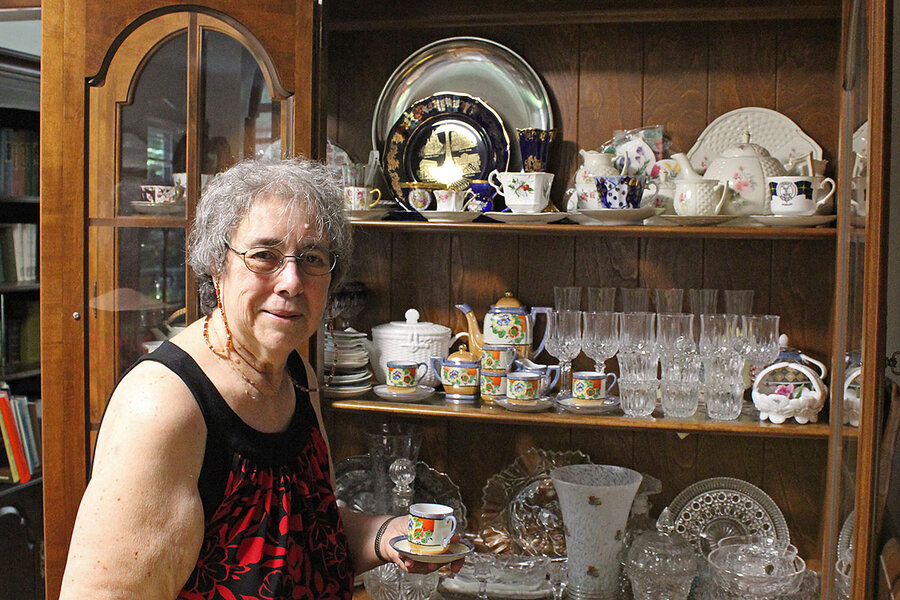Boomer parents: 'One day, this will all be yours.' Grown children: 'Noooo!'
Loading...
| Boston
Two hundred stuffed animals, two violins, and a 7-1/2 foot-tall Christmas tree: That was just a corner of the possessions Rosalie and Bill Kelleher accumulated over their 47-year marriage. And, they realized, it was about 199 stuffed animals more than their two grown children wanted.
Going from a four-bedroom house in New Bedford, Mass. – with an attic stuffed full of paper stacked four-feet tall – to a 1,300-square-foot apartment took six years of winnowing, sorting, shredding, and shlepping stuff to donation centers.
Among the possessions the Kellehers are keeping are three hutches – one that belonged to his mother, one that belonged to her mother, and one that they purchased together 35 years ago. One shelf is carefully lined with teacups Rosalie collected during her world travels. Another houses a delicate tea set from Japan, a gift her mother received on her wedding day.
“We really don’t need them,” she admits.
That refrain is becoming a common one as baby boomers begin to downsize and discover (as many generations before them have) that their children do not want their stuff. In fact, they recoil in something close to horror at the thought of trying to find room for the collections of Hummels; the Thomas Kinkade paintings; the complete sets of fine china and crystal, carefully preserved and brought out at holiday meals.
For their parents, to have a lifetime of carefully chosen treasures dismissed as garage-sale fodder can be downright painful.
“When [people] try to throw something away, they feel like they are losing ... personal history, losing a bit of themselves, losing a little of their identity, and they fear if they get rid of it they’ll never have that same experience again,” says Randy Frost, a psychology professor at Smith College and co-author of “Stuff: Compulsive Hoarding and the Meaning of Things.”
While every generation has its turn with an attachment for antiques or nostalgia for outdated technology, today’s tech-heavy culture shows few signs of trading in its sleek, modern designs for dark furniture or knick-knacks from bygone eras. And many younger families see trips, vacations, and photos as the repository of family memories – not shelves full of mementoes.
“Their kids ... oftentimes have homes already, they have families already, they have furnishings already,” says Kate Grondin, owner of Home Transition Resource in Andover, Mass. Ms. Grondin is part of a senior move-management industry that will pack, move, unpack, sell, and donate clients’ things as they move to smaller homes.
There are other signs that the next stop for those attic treasures may be the town dump. “The Life-Changing Magic of Tidying Up,” by Marie Kondo with a specific process for getting rid of things, has sold 1.5 million copies since 2014 in the United States. Joshua Fields Millburn and Ryan Nicodemus, otherwise known as The Minimalists, have published several bestselling memoirs, produced “Minimalism: A Documentary About the Important Things” in 2016, and are currently traveling across the US in their “Less is Now Tour 2017.”
When a pile of possessions has come to embody a sense of identity – or even what someone could yet become – it’s not always easy to figure out what should stay and what should go.
Dr. Frost recounts the story of a woman who “saved all of these cookbooks and all these recipes,” even though she didn’t really know how to cook. “If she were to try to throw some of that stuff away,” he explains, “that [removes] the opportunity for her to become the cook she thinks she’d like to be. In a sense, it’s removing a potential identity for her.”
‘You know you don’t have space for it’
Judy Maguire of Andover, Mass., and her siblings helped their mother move to an assisted living facility after their father died. They carefully selected some furniture and photographs that would make her feel at home.
But then they faced the difficult task of figuring out which heirlooms to keep for themselves.
“We were all pretty sentimental,” Ms. Maguire admits.
She recalls the siblings arguing over one particular piece – not over who would get it, but how to stop one sister from keeping what Maguire describes as a “big, hideous piece of furniture.”
“I said, ‘You know you don’t have the space for it. You don’t really need that.’ And she said, ‘I know, ... I just can’t let go of it,’ ” Maguire says.
They ended up donating the table.
Dr. Frost suggests posing a simple question for those going through this process: “How does this object … fit into your life?”
The Kellehers created staging sections in their house for specific items, using their kids’ vacant rooms, the living room, and the sunroom. Eventually, all of the leftover items to be taken away fit into the downstairs rec room, half of which had been filled with empty cardboard boxes being saved for some potential use.
Others have found that parting ways with familiar possessions actually brings a sense of freedom.
‘It’s like he’s still in college’
Carolyn Ledewitz of Cambridge, Mass., discovered that her son didn’t want anything when she downsized. “My son drove all the way up from New York City to go through his childhood things. I was appalled [when] he just grabbed them out of the boxes and dumped them into the trash,” she says.
Ms. Ledewitz describes her 40something son’s apartment as “so sparse – it’s like he’s still in college. He doesn’t have a single picture on the wall” of his Manhattan apartment, she says.
But Ledewitz ended up adopting some of her son’s attitude to achieve her goal of living in a sleek city condo in Boston’s Seaport district. She and her husband made the transition in two steps. First, they downsized from their ranch home in Springfield, Mass., where they had lived for 33 years into a three-story town home nearby.
“I had a china cabinet in my dining room with all my wedding presents ... my mother’s sugar bowl, the silver. I just loved it. I would look at it every day,” she says.
Ultimately, she says, the lifestyle she wanted outweighed the things she thought she cherished.
“Over the years, when you can’t hand it down, you have to let it go,” she says. She and her husband are now living out their urban dream.
That said, even professionals are not immune to temptation: Of all their late father's possessions, Nan Hayes and her siblings found themselves squabbling about a large statue of a conquistador. (Ultimately, the brother whose vehicle could transport it lugged home the booty.)
Ms. Hayes, the business development director of Caring Transitions, spent 10 years as a transition specialist helping individuals downsize their possessions and homes.
“The part of the job I miss the most,” she says, is seeing her clients “so much happier to be where they are because they know it’s where they need to be.”
“[Downsizing] was challenging, but it was good for [my husband and me],” Ledewitz admits. “It’s been so nice not worrying about all that stuff…. Life is much simpler without all that maintenance.”








